Urea is the leading nitrogen fertilizer worldwide. The International Fertilizer Association (IFA) is expecting a capacity increase of 8.1% by 2021 – most of this within the next two years.[1] In many cases, there is a demand for special fertilizers to meet very specific requirements, for example in respect of bioavailability.
Not every technology is suitable f or the industrial production of special fertilizers containing urea, since aqueous suspensions with urea and urea condensates are extremely difficult to dry.
As a result of this, three years ago, the Swiss company Hauert Dünger AG, the German firm Schneider Planta Chemicals GmbH and the Dutch chemical company ChemCom Industries B.V., together sought a suitable technology partner for the production of such intelligent urea fertilizers. Hauert is Switzerland’s market leader in horticultural fertilizers and has been operating successfully in the fertilizer market since its establishment in 1663. For a long time it has been supported actively by Schneider Planta Chemicals GmbH. ChemCom is located near the German border; among other things it manufactures urea-based resins and also reaps the benefits of a modern industrial estate.
The new fertilizer production facility was to be established on this industrial estate. The main reasons for choosing this location were an adequate supply of the constituents needed for the process, an excellent infrastructure with access to a port, and the possibility of making practical use of the process waste heat from the industrial estate, which had not been us ed in the past.
Granulation by means of fluidised bed technology proved to be the most suitable method for achieving the desired product quality. Fluidised and spouted bed technologies are the leading methods of particle formation by spray granulation, spray agglomeration, spray coating and spray encapsulation.
For the development of the process and construction of a tailor-made fluidised bed granulator, the group brought in Glatt Ingenieurtechnik from Weimar, Germany – a specialist in particle design, process development and plant construction.
Definition of the task
The first challenge was to produce dustless granulates capable of use in a further compacting process from the liquid raw material. Initial tests on single-stage fluidised bed units from other suppliers had already shown the method to be suitable in principle, but the quality of the results was poor. Due to the intense stickiness of the urea-based raw liquid, it was impossible to achieve stable process control. The granules stuck together again and again, so that the particle movement in the fluidised bed collapsed after a short processing time. Therefore, it was decided to carry out a feasibility study on a multistage pilot plant at the Glatt Technology Centre in Weimar.
The Glatt fluidised bed granulator, GFG, designed for continuous processing offers the necessary flexibility for realising such highly specialised applications. Suitable fittings inside the unit can create several different processing zones in which different temperatures and particle movements exist simultaneously. The size of the processing zones influences the retention time of the particles in each particular zone and thus the thickness of the layer of material applied to the particles in that zone. In the same way, drying zones and cooling zones can be combined with granulation zones in a single unit.
Another important advantage of this technology is the exhaust filter installed directly above the fluidised bed, which makes it possible to dedust the exhaust air inside the fluid bed unit. As a result, the dusts, which are strongly hygroscopic in this case, remain inside the unit and are used directly for the production of new granules. The filter also prevents problems with systems for the transportation of such difficult dusts. If this w as successful, upscaling to the planned production capacity and the design and construction of a fluidised bed plant were to follow.
Feasibility study: particle design
The purpose of the feasibility study was to test the growth of the particles layer by layer, like the structure of an onion, preventing stickiness on the surface of the particles. To achieve this, the process had to have a growth zone and a suitable zone for stabilising and hardening the particle surface.
The existing pilot plant at the Technology Centre in Weimar and its peripheral equipment were adapted accordingly. In order to obtain meaningful results from the study, it was also essential to process the liquid raw material as soon as possible after production, while still hot. Cooling would have changed the characteristics of the raw material and thus affected both the growth behaviour and the biological properties of the final product.
During the trials with this multistage fluidised bed process, the size of the zones and the parameters applied to the individual process zones were adjusted in such a way that it was finally possible to produce a compact granulate with a target particle size of 1.5 mm on a continuous basis. In this process, the particles in the growth zone were wetted with a thin layer of spraying liquid, this being fixed by a convective drying and hardening process within a defined time in the stabilisation zone. Not until then did the granulates pass through the growth zone again. In this way, a stable process was achieved. Samples were tested in the Glatt laboratory for their residual moisture, particle size and structure (Figures 1 – 2). Analytical verification of the bioavailability of the enhanced fertilizer produced in this way was carried out at the customer’s own laboratory.
Second test series: modified product quality
The successful initial tests generated ideas for new products, so the fertilizer granulates were to be optimised for a further application in a second series of tests. In order to prevent the components of a fertilizer blend from separating during filling and transportation, all the components must have a similar particle size. Consequently, the aim of the second test series was to establish an equally stable granulation process by which nearly spherical granulates 2 – 2.5 mm in size could be produced from the same liquid raw material (Figures 3 – 4).
In addition to the thermodynamic conditions in the respective process zone, fluidising velocity and the way in which the liquid raw material is applied to the particle surface play an important role. These must be matched to the desired size of the granules as well as to the desired granule structure. In most cases, this can be used to determine whether round granules or irregularly shaped particles are formed.
In order to discharge only granules of the correct size from the plant, the desired product fraction was separated off with a sieve. Oversized granules were first ground to a defined size and then returned directly to the fluid bed together with undersized granules (Figure 5).
Planning of the plant and process
The information acquired from the trials for the necessary process parameters and defined product streams between the growth zone and the stabilisation zone was used in both the technical design of the fluidised bed granulator and the strategy for a flexible periphery of the unit.
Besides the possibility of manufacturing different product qualities, it was essential for the project as a whole to optimise the production plant from the point of view of economy. In this case, it had to be taken into account that electric power is very expensive in the Netherlands. So, in order to reduce the primary energy requirement, the geometry of the stabilisation zone was planned specifically to meet the customer’s needs. In this way, it was possible to reduce the electric power requirement by approximately 15% and the heating energy requirement by approximately 20% as compared to a granulator with standard geometry.
Moreover, of course, it is always necessary to consider the regulations and standards in force at the location of the facility when planning the equipment – in this case a specific limit for emissions. In order to comply with this, the exhaust air system was configured to the dust limit of <5 mg/m3 required by the local Dutch authorities.
Delivery and installation
The fluidised bed granulator was built in Germany and delivered to the production location by water. The installation of the building and plant was carried out at the responsibility of ChemCom and in close cooperation with Glatt. In several visits to the site, the Glatt project team ensured that the personnel erecting the building, the partners installing the equipment and the company responsible for automation of the process adhered to the specifications provided by Glatt.
Commissioning
During commissioning of the plant three months later, it was first necessary to determine suitable parameters for the upstream process of producing the raw material in the existing reactor in close collaboration between the experts from ChemCom, Schneider Planta and Glatt in order to guarantee the quality tested in the granulation process during the pilot project. Hauert’s environmentally friendly, slow-release urea-based fertilizer came onto the market in 2015 and has excellent release properties based on microbial activity.
Conclusion
The construction and commissioning of a new production plant can be realised quickly if the partners in the project collaborate intensively and select a reliable group of suppliers. The unique flow characteristics and thermodynamic properties of fluidised and spouted beds offer great potential for heat and mass transfer processes of many different kinds, which frequently cannot be realised with other technologies. Energy-intensive processes can also result in economical solutions if the interaction between raw materials, utilities, and process and plant parameters is planned and realised intelligently.
An important condition is that stable upstream processes for production of the raw material have already been established.
As the example of the production of enhanced urea fertilizers shows, it is also important for the plant to be adjustable to different product parameters in order to permit a flexible response to changes in market requirements. Plant and machinery from Glatt is installed all over the world, taking into account individual local conditions, and is adapted and optimised for energy efficiency. Feasibility studies are necessary in order to develop new types of products or optimise products or production methods already established. To permit this, plant of different sizes is available, from the laboratory and pilot scale to the full scale production level.
Urea condensates – the clever fertilizer component
With a content of 46.63%, urea exhibits the highest nitrogen content of all nitrogen fertilizers. Numerous soil microorganisms catalytically hydrolyse urea to ammonia and carbon dioxide via the enzyme urease.[2] Due to the climatic conditions, emissions of ammonia do not present a significant risk in northern and central Europe. Therefore, in agriculture and gardening, convenient and safe handling – both from the economic and the ecological point of view – and controlled release of nitrogen are the main requests. In order to achieve these requirements, nitrogen fertilizers are increasingly refined. Slow-release fertilizers should not release their nitrogen rapidly; this release should be adapted to the needs of the plants. Leaching or outgassing of nitrogen resulting in nitrogen loss have to be minimised. Methyleneureas, which are condensation products of urea and formaldehyde, fulfill these requirements. Soil microorganisms enzymatically catalyse the degradation of methyleneureas to finally ammonia and ensure continuous release of nitrogen from these products during plant growth. The main advantage is dependence of this microbially catalysed nitrogen release on temperature, pH and soil humidity, which is adjusted to the plants’ growth and their need for nitrogen. In order to achieve this, the short and long chain methyleneurea condensation products have to be present in a particular ratio.[3], [4]
Typical fluidised bed process
Spray granulation combines convective drying or solidification and particle formation in a single process step. A fluidised bed forms when a particulate material is perfused with a gaseous fluidising agent – usually air – and set in motion. The rule is: the higher the speed of the gas, the more intense the movement of the particles.[5] A spraying liquid containing solids is applied to the fully accessible surface of the particles. The solvent – usually water – evaporates, and the remaining solids dry and adhere to the surface of the particles. The granulation cores usually consist of the same material. The cores are produced either directly in the process by spray drying or abrasion, by the return of fine particles, or by crushed granules from the screening milling cycle (Figure 5). Special geometry of the fluidised bed granulator makes it possible to combine different process steps or stages in a single unit and control the retention time of the particles in the various stages. In this case we speak of a multistage fluidised bed process.
References
1. IFA Annual Conference, Marrakech, 22 – 24 May 2017, ‘Fertilizer Outlook 2017 – 2021, PIT and Agriculture Services, IFA.
2. TISDALE, S. L., NELSON, W. L., and BEATON, J. D., ‘Soil fertility and fertilizers’, Macmillian, 1985, ISBN 0-02-420830-2, pp. 161 – 168.
3. JAHNS, T., SCHEPP, R., SIERSDORFER, C., and KALTWASSER, H., (1999), ‘Biodegradation of slow-release fertilizers (methyleneureas) in soil’, J Environment Polymer Degrad 7: 75-82.
4. EWEN, H. and JAHNS, T., (2000), ‘Bacterial degradation of methyleneureas used as slow-release fertilizer’, Recent Res Devel Microbiology 4: 537-546.
5. JACOB, M., (2007), ‘Effiziente Wirbelschichtapparate dank Simulation’, P&A-Kompendium 2007/2008, pp. 24 – 27.

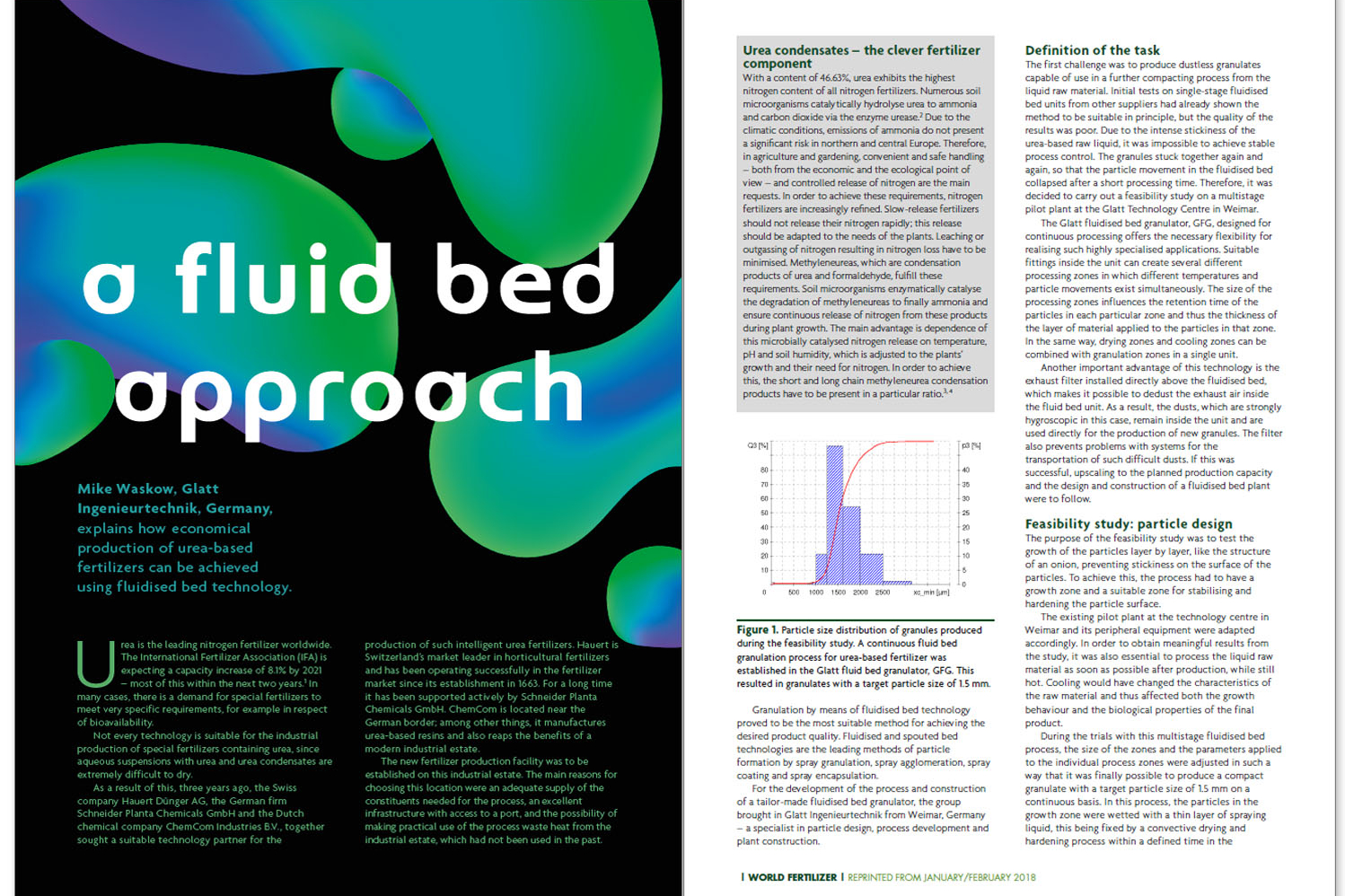
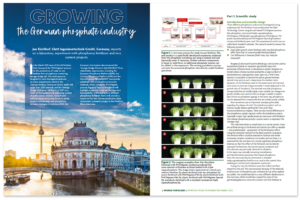
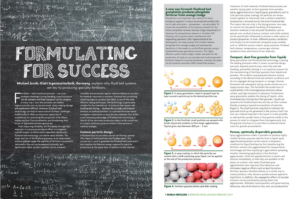
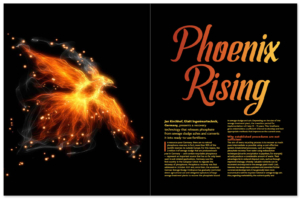
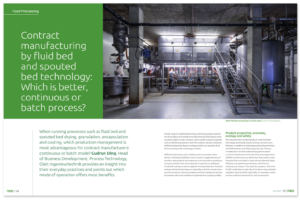
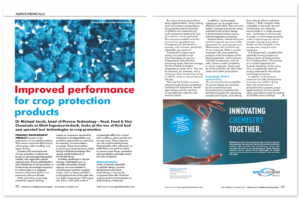
 Copyright: J.Latka Verlag GmbH
Copyright: J.Latka Verlag GmbH